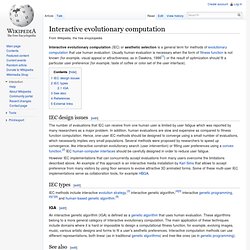

Genetic algorithm. The 2006 NASA ST5 spacecraft antenna.

This complicated shape was found by an evolutionary computer design program to create the best radiation pattern. Genetic algorithms find application in bioinformatics, phylogenetics, computational science, engineering, economics, chemistry, manufacturing, mathematics, physics, pharmacometrics and other fields. Methodology[edit] In a genetic algorithm, a population of candidate solutions (called individuals, creatures, or phenotypes) to an optimization problem is evolved toward better solutions. Each candidate solution has a set of properties (its chromosomes or genotype) which can be mutated and altered; traditionally, solutions are represented in binary as strings of 0s and 1s, but other encodings are also possible.
Fitness function. A fitness function is a particular type of objective function that is used to summarise, as a single figure of merit, how close a given design solution is to achieving the set aims.

The reason that genetic algorithms cannot be considered to be a lazy way of performing design work is precisely because of the effort involved in designing a workable fitness function. Even though it is no longer the human designer, but the computer, that comes up with the final design, it is the human designer who has to design the fitness function. Interactive evolutionary computation. Interactive evolutionary computation (IEC) or aesthetic selection is a general term for methods of evolutionary computation that use human evaluation.

Usually human evaluation is necessary when the form of fitness function is not known (for example, visual appeal or attractiveness; as in Dawkins, 1986[1]) or the result of optimization should fit a particular user preference (for example, taste of coffee or color set of the user interface). IEC design issues[edit]